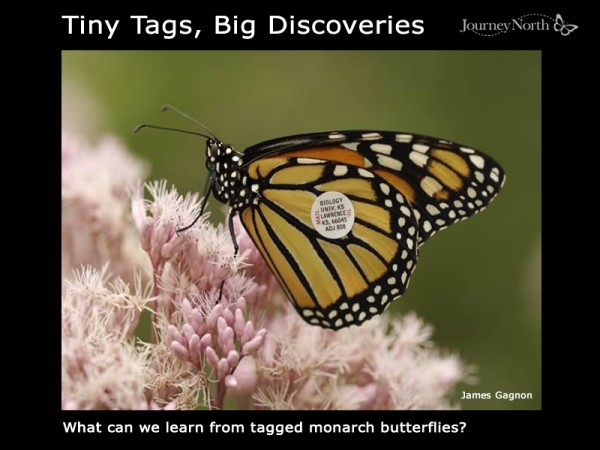Tiny Tags, Big Discoveries
Teaching Suggestions
Overview
Every fall people all over North America carefully catch monarchs, and place a tiny, paper ID tag on one wing. The tagged butterflies are released and continue their journeys. When a tag is recovered, valuable information about migration is revealed.
Driving Question: What can we learn about migration from tagged monarch butterflies?
For use with Photo Gallery: Tiny Tags, Big Discoveries and Articles: True Tagging Stories
Activities
1. Examine a photo of a tagged monarch.
As students examine a photo of a tagged monarch, ask questions to spark curiosity:
- Why does this monarch have a sticker?
- Why are they captured and tagged in the fall?
- Who tags monarch butterflies and why?
- What information is on a tag?
- What kinds of information can we learn from the journey of tagged monarchs?
2. Read a true story about the recovery of a monarch tag.
Preview the story by having students imagine what it would be like to catch and tag a monarch butterfly in the fall. Ask questions to help them start thinking about what kinds of information we can learn from tagged monarchs:
- Imagine your newly tagged butterfly flying off from your backyard. How far will it travel in a few hours, days, or weeks?
- How fast will it fly on its journey?
- Will it travel along the same pathways of previous migrations?
- Will the butterfly fly over mountains and oceans?
- How will the weather affect its travel?
- Will the butterfly survive and reach the overwintering site in Mexico or will it be discovered somewhere else?
- What will happen when someone else sees or finds your tagged butterfly?
Introduce the story, The Monarch Tag that Traveled Round Trip:
Here’s a tale about a tag that was discovered in Mexico a few years ago. As you listen, imagine that you are the person who placed the ID tag on the monarch butterfly.
Read aloud the story, noting details about the dates, times, and locations of tagging and recovery. Think aloud to show students how to identify important tagging and recovery data, make conclusions from the data, formulate hypotheses, and ask questions using details in the story.
3. Explore more stories about tagged monarch butterflies.
Place students in small groups. Have students choose one of the stories.
Steps
- Mark the monarch's tagging and recovery locations on a blank map.
- Examine the tagging and recovery data and draw conclusions: distance traveled in a certain amount of time, geographic features encountered along the migratory path, and more.
- Focus students’ attention on the surprising and unexpected events described in the stories of tagged monarchs. Challenge them to use their knowledge, experience, and imaginations to come up with possible explanations for unexpected findings. Share students’ hypotheses and explore the factors that led to their explanations of the surprising events described in the stories.
- Ask questions to help students think about factors that might relate to what happened: Could a change in the environment (e.g., short-term weather, long-term climate) be a reason for what happened? Could a human factor be responsible (e.g., development or deforestation that affects an animal's normal habitat)?
- Reread the stories to identify questions raised by the people who tagged or recovered the butterflies. Invite students to share their own questions.
- Encourage students to explore their hypotheses and questions: What new data or information would help us check and further refine our explanations?
4. Examine tagging data on a map.
Look at Dr. Urquhart’s tagging data on a map made available by Monarch Watch, a citizen-science project at the University of Kansas. Have students use the map to collect data, draw conclusions, make hypotheses, and ask questions. Challenge them to think about how tagging data, stories, and maps can assist scientists who study monarch populations and fall migration. What are researchers hoping to learn about monarchs and their migration by analyzing tagging data?
5. Analyze tagging data.
After reading stories and examining maps, analyze tagging data by looking for patterns and comparing/contrasting similarities and differences.
6. Extend students’ learning.
A tag weighs about 2% of a monarchs' body weight. Have students figure out 2% of their own body weight. Ask discussion questions: How would you carry 2% of your body weight? How heavy or light is the 2%? What did this activity help us learn about the tags attached to a monarchs' wings?



